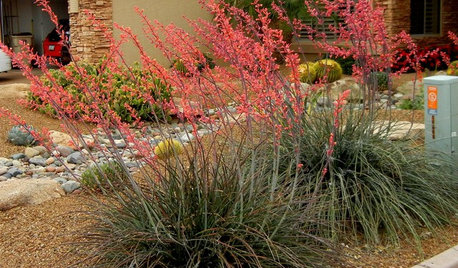Silver queen sweet corn vs Johnson grass.
OK-Hicks
10 years ago
Related Stories

SUMMER FRUITS AND VEGETABLESHow to Grow Your Own Fresh, Sweet Corn
Here's how to plant and care for your own mini cornfield
Full Story
GARDENING AND LANDSCAPINGWorld of Design: 10 Home Gardeners Show Us Their Sweet Summer Harvests
From New York to Tokyo, these gardeners have turned their yards, terraces and rooftops into places of bounty
Full Story
DECORATING GUIDESA Subliminal Approach to Fall Decorating
Get your home in the autumn groove without going over the top, with decorating ideas from two top San Francisco designers
Full Story
GARDENING FOR BUTTERFLIESGreat Design Plant: Red Yucca Spikes Dry Spots With Color
Neither heat nor cold nor lack of water fazes this flowering succulent, which adds spiky texture to Southwestern landscapes
Full Story
LIFEHouzz Call: Where (and What) Are You Reading This Summer?
Whether you favor contemporary, classic or beach reads, do the long and lazy days of summer bring out the lit lover in you?
Full Story
DESIGNER SHOWCASESGlamour Ahead: Get In on the 2013 San Francisco Decorator Showcase
Take an inspiring virtual tour of 20 luxurious spaces in a Georgian mansion that push design and decorating drama to the max
Full Story
LIFESimple Pleasures: Indulging in Teatime
Get out the china cups and cream-slathered scones. Tea with treats can make even an uneventful day feel extravagant
Full Story
GARDENING FOR BUTTERFLIES3 Ways Native Plants Make Gardening So Much Better
You probably know about the lower maintenance. But native plants' other benefits go far beyond a little less watering and weeding
Full Story
FUN HOUZZEverything I Need to Know About Decorating I Learned from Downton Abbey
Mind your manors with these 10 decorating tips from the PBS series, returning on January 5
Full Story
FARM YOUR YARDIf You Have Room for Only One Summer Crop ...
Get an edible that’s long on flavor even if you’re short on space, with a long-time gardener’s favorite picks
Full StorySponsored
Columbus Design-Build, Kitchen & Bath Remodeling, Historic Renovations
More Discussions






ScottOkieman
scottokla
Related Professionals
Franconia Landscape Architects & Landscape Designers · Concord Landscape Contractors · Amesbury Landscape Contractors · Bell Gardens Landscape Contractors · Brunswick Landscape Contractors · Forest Hills Landscape Contractors · New Cassel Landscape Contractors · Cape Coral Decks, Patios & Outdoor Enclosures · Foothill Farms Decks, Patios & Outdoor Enclosures · Grandview Decks, Patios & Outdoor Enclosures · Hockessin Decks, Patios & Outdoor Enclosures · Kernersville Decks, Patios & Outdoor Enclosures · Rocklin Decks, Patios & Outdoor Enclosures · Shirley Decks, Patios & Outdoor Enclosures · Santa Monica Decks, Patios & Outdoor Enclosuresmulberryknob
Okiedawn OK Zone 7